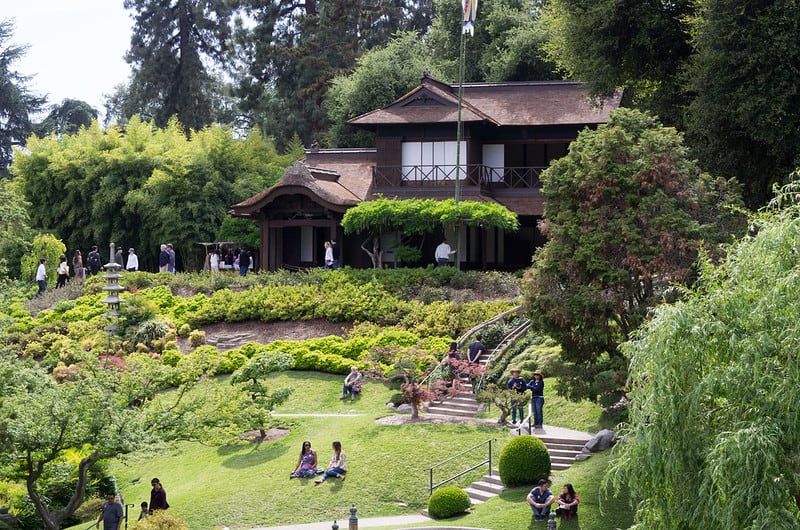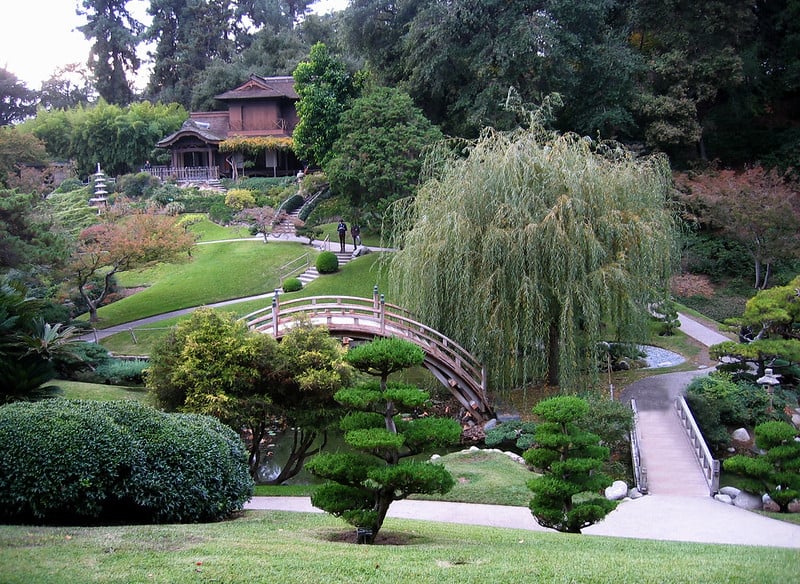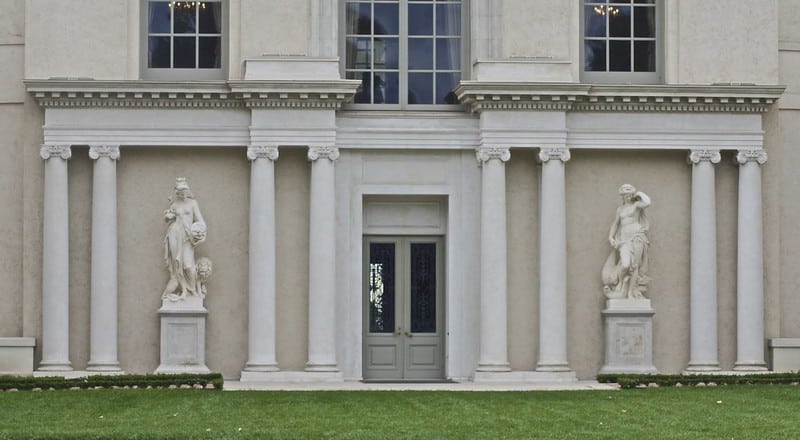Whether you’re local to Southern California or just visiting, the Huntington Library, Art Museum, and Botanical Garden in San Marino is the ultimate destination for any nature, art, or history enthusiast!
This 207-acre complex is home to 16 different gardens, multiple art galleries, an exhibition hall, several research facilities, and more.
With so much to see and do at the Huntington, you won’t want to miss a single thing. This guide will help you make the most of your trip and make sure to hit all the highlights!
Insider Tip: What is on view at the Huntington can change quickly! Many of the plants are seasonal and the galleries may rotate some parts of the collection. Check the website and social media before you go to get an idea of what will be available during your visit.
Things to Do at the Huntington Library & Gardens
Dive into history and pop culture.
Note: This post contains affiliate links, which earn me a small commission at no extra cost to you if you make a purchase using one of these links. Thank you for supporting this free content!

The Huntington is located on the site of Henry E. Huntington and Arabella Huntington’s property, and the complex includes the original 1911 Gilded-Age era Beaux-Arts-style mansion.
During their lifetimes, the couple amassed an extensive literary and art collection. In 1919 they turned their property and collection into a public institution, which opened to the public for the first time in 1929.
The institution continued to grow after the Huntingtons’ time and is now known around the world for its spectacular gardens, art collection, and research library.
The Huntington is also an extremely popular filming site now! While you’re walking the grounds, look out to see if anything looks familiar.
Hit movies and television shows like Criminal Minds, CSI, Iron Man 2 and 3, Parks and Recreation, The Good Place, The West Wing, and many more filmed scenes throughout the grounds.
Explore the Conservatory.

Start the day off with a visit to the Conservatory!
To get there, you’ll take a right after passing through the ticketing area, walk through a small sculpture garden, and then see the large glass structure.
The Conservatory is home to two simulated climates, a cloud forest and a rainforest, and nurtures rare plants from around the world.
One of the Conservatory’s greatest highlights is the amorphophallus titanium, otherwise known as the corpse flower due to its powerful stench.
This flower can take as long as 10 years to bloom for the first time, after which it blooms rarely and irregularly.
Check out the Huntington’s Instagram to see when it’s blooming and to catch a live stream!
Let your imagination run free in the Children’s Garden.

If you have kids in tow, make a pit stop at the Children’s Garden, located just outside the Conservatory.
This garden is an interactive playground filled with water to splash in, tunnels to explore, and topiary animals to fuel the imagination.
Appreciate the landscape at the Camellia Garden.

Next, head towards the Camellia Garden which is home to over 1,000 varieties of camellias, making it one of the largest collections in the world.
This garden also features a lovely fountain where you can catch gorgeous views of the Huntington Art Gallery.
Step back in time in the Shakespeare Garden.

Next to the Camellia Garden, you’ll find a meandering path through the Shakespeare Garden.
This garden was inspired by the time and writings of Shakespeare, and you’ll see all sorts of plants that Shakespeare mentioned in his plays and that were grown in England during his lifetime.
Stop and smell the Rose Garden.

If you follow the path of the Shakespeare Garden away from the Camellia Garden you’ll find yourself right in the Rose Garden.
Arabella Huntington loved roses, and this garden dates back to 1908—before the mansion was completed.
The garden now spans three acres and includes over 1,300 varieties of roses.
Make sure to see the Huntington’s unique hybrid rose called “Huntington’s 100th”.
It was developed by the curator of the rose collection for the Huntington’s 100th anniversary
Get lost in the Japanese Garden.

From the Rose Garden, follow the trellis-covered sidewalk to a pathway that will lead you through the trees and into the Japanese Garden.
This nine-acre garden dates back to 1912 and is probably the most iconic and popular part of the Huntington grounds.
There is so much to see here that you could spend the entire day and still find new things on your next visit!
Follow the winding paths to explore all the different elements of this fascinating garden. Make sure to admire the arch bridge from all angles for some truly extraordinary photo opportunities!
Check out the two historic structures in the garden, the Japanese House and the Ceremonial Teahouse. Both buildings were built in Japan and then shipped in pieces to the U.S. where they were reconstructed.
Tucked away near the Japanese House you’ll also find the Bonsai Collection and the Zen Court. These hidden treasures are a must-see.
Wander the Chinese Garden.

If you follow the pathway upstream from the Japanese Garden, you’ll discover the stunning and recently expanded Chinese garden.
This 15-acre garden, titled Liu Fang Yuan, or the Garden of Flowering Fragrance, is a more recent addition to the Huntington Gardens and is a fabulous example of the classical style of Chinese gardening.
The garden was designed by landscape architects in Suzhou, China, home to the Classical Gardens of Suzhou.
Now a UNESCO World Heritage site, the Suzhou Gardens is where the classical Chinese style of gardening developed during the Ming Dynasty.
Elements of the Suzhou style were incorporated throughout the Chinese Garden at the Huntington, including respect for the local environment, the use of plants with symbolic meaning, and the incorporation of unique rock elements.
Stroll around the central pond and explore all the different elements of this thoughtfully crafted garden.
Spend a few minutes in the Love for the Lotus Pavilion for spectacular views of the garden and to admire the woodcarvings. Look for images of gardens in the woodcarvings—these are images of the Suzhou gardens!
Explore the new Verdant Microcosm, a section of the garden that features penjing—the historic Chinese art of crafting miniature landscapes.
Browse American art at the Virginia Steele Gallery.

While you could absolutely spend the entire day wandering the expansive gardens, the Huntington has some extraordinary pieces of art and history in the collection that you won’t want to miss!
After your stroll through the Chinese Garden, explore the American art collection at the Virginia Steele Scott Gallery.
This collection of American art includes paintings, furniture, sculptures, and more from all periods of U.S. history.
Some of the highlights include paintings by Mary Cassatt and John Singleton Copley.
Peruse the European art collection at the Huntington Art Gallery.

Continue to explore the art collection at the Huntington Art Gallery which is located in Arabella and Henry Huntington’s mansion.
Here you can explore the phenomenal collection of 15th through early 20th century European art on display.
Make sure to see Blue Boy by Thomas Gainsborough and Pinkie by Thomas Lawrence. These are probably the two most beloved pieces on display at the Huntington!
Other highlights include the painting Portrait of a Man by Domenico Ghirlandaio and the sculpture Diana the Huntress by Jean-Antoine Houdon.
In addition to the art, the gallery’s setting in the Huntingtons’ home gives visitors the opportunity to view elements of the original home.
Explore the building to experience the Gilded-Age-era mansion and the Beaux-Arts architecture.
Bookworms will also appreciate the opportunity to explore Henry Huntington’s expansive library and den!
Examine historical treasures at the Exhibition Hall.

After exploring the art collections, head over to the exhibition hall to see some of the most important pieces of European history.
On display is one of 48 surviving copies of the Gutenberg Bible. The Gutenberg Bible, printed using movable metal type, is famous for being the earliest book printed in Europe.
This copy is one of 12 surviving copies printed on vellum and is the only copy on the U.S. West Coast!
You can also see Shakespeare’s First Folio on display. This folio contains 36 of Shakespeare’s plays, many of which were printed for the first time.
Possibly because plays were often performed from memory, several different versions of Shakespeare’s plays emerged.
To establish an official version of the plays, Shakespeare’s friends compiled his work into this folio which is now considered to be the earliest and most authoritative source on these plays.
Another highlight in the Exhibition Hall is the first edition of Isaac Newton’s Principia.
Published in 1687, Principia presents Newton’s laws of motion, planetary motion, and gravity. It is widely considered to be one of the most significant scientific works in history.
Grab a bite to eat.

There are plenty of dining options at the Huntington if you get hungry during your long day of exploring gardens and immersing yourself in art and history.
For a quick bite check out the Red Car coffee shop which will get you back out amongst the flowers ASAP.
If you’re in the mood for something more substantial, the Jade Court Cafe and the 1919 Cafe provide a range of fabulous options.
If you have a bit more time, consider having tea at the Rose Garden Tea Room. This exquisite experience features the Huntington’s take on a classic tea service in the gorgeous Rose Garden setting.

Hilary Blum is a public historian and a freelance writer based in the Pacific Northwest. Originally from Southern California, she is always planning the next adventure and has traveled and lived all around the world. She spends her free time baking, reading, visiting museums, and fawning over her two cats.

